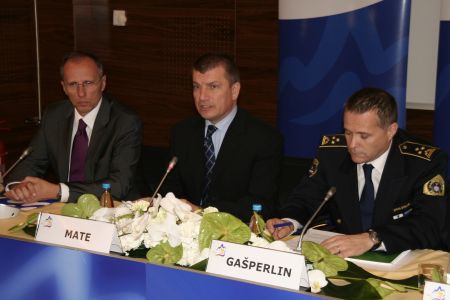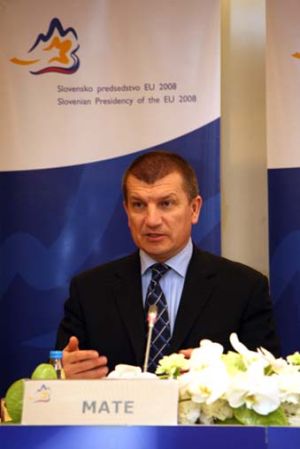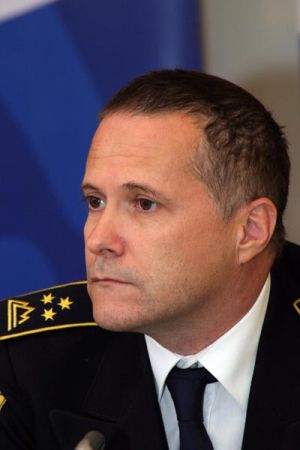After lifting the checks at the internal land and sea borders on 21 December 2007, when Slovenia and eight other Eastern and Central European countries entered the Schengen area, border checks were also lifted at air borders one minute after midnight yesterday, 30 March 2008.
At today's press conference at the Ljubljana Jože Pučnik Airport, the representatives of the Ministry of the Interior, the Police and Aerodrom Ljubljana underlined the historic significance of this event for Slovenia as well as other Schengen countries, particularly in providing security in the Schengen area. Further, they explained the advantages that the introduction of the Schengen regime at the Slovenian airports brings for air passengers in practice.

Dragutin Mate, Slovenian Minister of the Interior and President of the Justice and Home Affairs Council, described the lifting of border checks at air borders as representing the removal of the last obstacles and the final entry into the Schengen area, bringing long-term positive effects for all the new Schengen area Member States, and consequently strengthening the ties within Europe as an area of security and freedom. He said: "In reality this represents full implementation of the idea of free movement of people, without stopping and waiting due to border controls. For our citizens and all other passengers travelling within the Schengen area, this is a great advantage and a privilege."
 According to Minister Mate, the Schengen enlargement has increased the number of destinations available to passengers where they can travel without formalities such as border checks. Moreover, efficient implementation of measures at the external border and inside the area is in the security interests of the entire European Union, including Slovenia. "Namely, the basic purpose of the Schengen regime is not to decrease security in the area as a result of lifting the border checks, but, on the contrary, to ensure greater security on account of better and facilitated cooperation between the police forces of the Member States. This is also true for air traffic security."
According to Minister Mate, the Schengen enlargement has increased the number of destinations available to passengers where they can travel without formalities such as border checks. Moreover, efficient implementation of measures at the external border and inside the area is in the security interests of the entire European Union, including Slovenia. "Namely, the basic purpose of the Schengen regime is not to decrease security in the area as a result of lifting the border checks, but, on the contrary, to ensure greater security on account of better and facilitated cooperation between the police forces of the Member States. This is also true for air traffic security."
Minister Mate added that the Schengen Information System has proved to be a very useful tool in providing security in the country and in the Schengen area. In the seven months since 1 September 2007, 9.56 million checks on persons, documents and vehicles have been carried out in the Republic of Slovenia by using SISone4all at the external borders. There have been 4,661 hits on wanted or missing persons or objects. Out of that number, 76 persons were apprehended, 3,187 persons were refused entry into the country, 31 missing persons and 9 missing minors were traced, while 196 counterfeit or altered documents were seized and 369 missing vehicles were traced. Abroad, 21 persons were apprehended based on European arrest warrants and international arrest warrants issued in Slovenia, while 4 missing persons were traced and 15 vehicles were seized based on alerts issued by Slovenia. "These numbers prove that the security of EU citizens, as well as Slovenians, has increased," stated Minister Mate.
Furthermore, Minister Mate emphasised that the activities of Slovenia, which since its entry into the EU in 2004 has been actively supporting other candidates in achieving common Schengen standards, have by no means been completed with yesterday's event. As a matter of fact, we are even more active now. "As the President of the Justice and Home Affairs Council, I am encouraging all the parties concerned to continue the project of the second-generation Schengen Information System (SIS II) following the new schedule. At the recent ministerial conference we discussed enhanced management of the external borders and the introduction of new technologies for border surveillance in the future, while Slovenia is already participating, with its experts, in the Schengen evaluation in Switzerland," concluded Minister Mate.
 Marko Gašperlin, Assistant Director of the Uniformed Police Directorate at the General Police Directorate, explained that the decision of the Justice and Home Affairs Council to open borders at airports later than the other borders had to do with the changes of timetables, which only take place twice a year, i.e. in spring and autumn. Another reason for the delay was technical, as the implementation of the Schengen regime at airports imposes a strict separation between passengers on Schengen and non-Schengen flights. The lifting of border checks at internal air borders was conditional on a positive outcome of the Schengen evaluation carried out at the Slovenian international airports. "In the first evaluation round in 2006 certain infrastructural deficiencies were found; however, by the second evaluation in July last year, Slovenia had built a modern passenger terminal with a state-of-the-art technology of border control, and received very good marks in the second evaluation round."
Marko Gašperlin, Assistant Director of the Uniformed Police Directorate at the General Police Directorate, explained that the decision of the Justice and Home Affairs Council to open borders at airports later than the other borders had to do with the changes of timetables, which only take place twice a year, i.e. in spring and autumn. Another reason for the delay was technical, as the implementation of the Schengen regime at airports imposes a strict separation between passengers on Schengen and non-Schengen flights. The lifting of border checks at internal air borders was conditional on a positive outcome of the Schengen evaluation carried out at the Slovenian international airports. "In the first evaluation round in 2006 certain infrastructural deficiencies were found; however, by the second evaluation in July last year, Slovenia had built a modern passenger terminal with a state-of-the-art technology of border control, and received very good marks in the second evaluation round."
As of yesterday, when the flight timetable changed, the police stopped carrying out border checks on internal Schengen flights at all three Slovenian airports with border crossings. Passengers boarding and disembarking from flights between two Schengen countries are not subject to any border or other checks by the police. The only remaining checks are security checks carried out by the airport staff or an authorised security company upon entry into the international zone or aircraft. Upon arrival passengers disembark, take their luggage and enter the country without any checks.
Therefore, according to Mr Gašperlin, there will effectively be no more waiting at entry into a country. This does not mean, however, that passengers can travel without documents. They still need a valid identity card or passport for travelling in the Schengen area, as well as the EU Member States. These two documents are the only ones that allow us to move within the Schengen area, even though border checks are not carried out any longer. The police may still, if there is due cause, carry out checks at any time as part of compensatory measures.
As of yesterday, the police only carry out border checks on non-Schengen flights, i.e. flights involving the crossing of the external border. On these flights border checks are carried out for all passengers entering or exiting the Schengen area, including transit passengers who continue their journey to non-Schengen countries. The old regime will remain in place, for example, on flights to London, as the United Kingdom is not a member of the Schengen area; passengers flying to London will be leaving the Schengen area and will therefore have to undergo border checks. The same is true of flights to Ireland, Bulgaria, Romania and Cyprus, which, though members of the EU, are not part of Schengen.
 Zmago Skobir, the President of the Management Board of the Aerodrom Ljubljana, the company that manages Ljubljana Jože Pučnik Airport, said that the lifting of border checks on internal flights represents an important step forward for us, since air passengers are increasingly demanding and critical when they face complex administrative and security procedures at airports. "Slovenia is a full participant in the European Union's single domestic market and the common area shared by the Schengen signatories in all respects, both market- and administration-related. With the elimination of border controls on internal flights, we, the residents of the Schengen States, have today become more closely connected and more easily accessible. I am convinced that entry into the Schengen area will also have a favourable impact on business in Slovenia. Joining the European Union, adopting the euro and eliminating border controls at the internal borders have given us a great opportunity to considerably speed up the increase in the number of passengers carried and the volume of cargo handled." According to Skobir, the Aerodrom Ljubljana invested 18 million euros in the construction of the first phase of the new passenger terminal, which was opened in July 2007 in order to ensure and organise passenger flows in accordance with the Schengen rules.
Zmago Skobir, the President of the Management Board of the Aerodrom Ljubljana, the company that manages Ljubljana Jože Pučnik Airport, said that the lifting of border checks on internal flights represents an important step forward for us, since air passengers are increasingly demanding and critical when they face complex administrative and security procedures at airports. "Slovenia is a full participant in the European Union's single domestic market and the common area shared by the Schengen signatories in all respects, both market- and administration-related. With the elimination of border controls on internal flights, we, the residents of the Schengen States, have today become more closely connected and more easily accessible. I am convinced that entry into the Schengen area will also have a favourable impact on business in Slovenia. Joining the European Union, adopting the euro and eliminating border controls at the internal borders have given us a great opportunity to considerably speed up the increase in the number of passengers carried and the volume of cargo handled." According to Skobir, the Aerodrom Ljubljana invested 18 million euros in the construction of the first phase of the new passenger terminal, which was opened in July 2007 in order to ensure and organise passenger flows in accordance with the Schengen rules.

